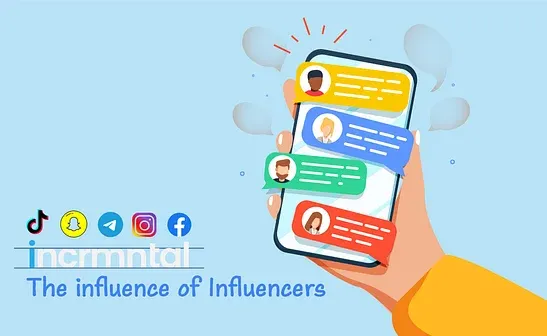Solutions
Teams
Built for your whole team.
Industries
Trusted by all verticals.
Mediums
Measure any type of ad spend
Platform
Use Cases
Many Possibilities. One Platform.
AI and Automation
The Always-on Incrementality Platform
Teams
Built for your whole team.
Industries
Trusted by all verticals.
Mediums
Measure any type of ad spend
Use Cases
Many Possibilities. One Platform.
AI and Automation
The Always-on Incrementality Platform

The growth of social platforms facilitated an explosion of creativity and more content than ever. With the growing popularity of social media channels comes the increase in content creators aka influencers. YouTube alone has over 70,000 channels that have more than 1,000 subscribers. TikTok has over 3 million influencers on its platform. What once was a new channel for marketers is now a must as the influencer marketing industry is set to be valued at 16.2 billion by the end of 2022. This growth comes down to two key changes: (1) The creation platforms that host short video formats such as TikTok and Instagram; (2) The effects of the global pandemic on social media consumption which in turn allowed for more data to be used by marketers for their specific social media needs.
The more popular term is influencers but they are often known as digital/ content creators, instagrammers, YouTubers and the like. Ultimately, an influencer is an individual that has the power to affect purchase decisions of others because of their authority, knowledge or status and/ or their relationship with their following. A following is considered to be a niche audience whom the influencer actively engages with and has formed a type of “relationship of trust”.
Influencers are often differentiated on the size and type of followers, from macro to niche, and on the genre or type of content that they create. There are also different levels of influence that a creator might have. These should all be considered when a brand is choosing an influencer to work with.
Influencer marketing is a form of social media marketing in which brands leverage the following or network of an influencer/creator typically this is one that matches the target audience of the brand. A brand’s two main goals for using influencer marketing are to increase brand awareness and drive sales. The power of influencer marketing lies in exactly that, their influence to drive decision making and increase purchasing power. In 2021, 49% of consumers depended on influencer recommendations. It seems that if a consumer is confident in the influencer’s recommendation they are more likely to make a purchase. Influencer posts play a key role in this strategy, as they serve as authentic endorsements that blend naturally into users' content feeds, making them more engaging and trustworthy than traditional ads. This is what brands are aiming to achieve through their collaborations with influencers, leveraging the trust and influence that influencers have when it comes to making purchasing decisions.
The influencer marketing industry is set to be valued at $16.4B by the end of this year.
It is one of the fastest growing channels. In 2016 it was only valued at $1.7 billion, and ever since it has seen continuous growth year over year. More importantly brands and marketers are seeing the results. Not only do influencers generate brand awareness but they also influence decision making. Given that more marketers are seeing the value in working with influencers, we can expect more brands to venture into this channel or increase their existing budgets.
As far as channels go, Instagram and Twitter are set to be the most effective platforms. As for the costs for this type of marketing range greatly, specifically depending on the brand goals and the type of influencer(s) they aim to work with, also more importantly to what degree the relationship is formed. The latter meaning the degree of collaboration, whether it is a one-off project or a long-standing retainer.
One report found that, influencer marketing campaigns earn $5.78 for every dollar spent with some seeing as much as $18. If you would like to get a better understanding of the potential ROI for your future campaigns check out the social media calculator.
Furthermore, the price will depend if the brand is working directly with the influencer or through an agency. Nowadays, the agency model is the most frequently used.
Yes! Just as the industry has boomed so have the companies and agencies that support the space. There has been a 26% growth of influencer marketing related services and companies that support both creators and influencers. Two of the leading players in the space are JetFuel and Hypefactory. Jetfuel is part of the Liftoff group and promises to connect you with the GenZ audience. HypeFactory is a data driven marketing agency that focuses on ad campaigns for Instagram, TikTok, YouTube and Twitch.
Now here comes the interesting part. How do you measure all that influence aka the untrackable campaigns? There are two main ways to do this. FIrstly, there is Smart Deep Link - referring iOS users to the Apple App Store, Android users to the Play store, Web users to a landing page. The challenge here is that only a fraction of users may click a unique URL towards the conversion point (i.e. install, sale). Links do not consider any impact the views had over conversions, and some platforms don’t allow influencers to paste in unique tracking URLs. And then comes the more holistic way, through incrementality measurement. Here you are creating a causal relationship between the influencer spends and the influence over marketing performance. Incrementality measurement offers a new method of measurement, rather than attempting to offer attribution of clicks to conversions, incrementality measures the actual contribution of marketing activities to value.
About INCRMNTAL:
INCRMNTAL is an always on incrementality measurement platform. Applying causal data science to marketing measurement, INCRMNTAL leverages the existing marketing activities to measure VALUE.
The platform allows companies to measure the value coming from marketing activities across mobile, web, influencers, TV and any other medium without the need to run any planned experiments.
Want to learn more ? Schedule a demo with us

Maor is the CEO & Co-Founder at INCRMNTAL. With over 20 years of experience in the adtech and marketing technology space, Maor is well known as a thought leader in the areas of marketing measurement. Previously acting as Managing Director International at inneractive (acquired by Fyber), and as CEO at Applift (acquired by MGI/Verve Group)